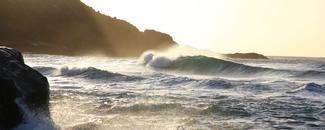Global Climatologies of Temperature, Salinity, Dissolved Oxygen, and Inorganic Nutrients

The NCEI’s Ocean Climate Laboratory (OCL) has released the full World Ocean Atlas 2023 (WOA23) Global Climatologies of Temperature, Salinity, Dissolved Oxygen, and Inorganic Nutrients. This is a five year update to enhance the previous version, World Ocean Atlas 2018 (WOA18).
A new version of the WOA is released with each extensive update to the World Ocean Database (WOD), the world's largest collection of uniformly formatted, quality controlled, publicly available ocean profile data that are FAIR-compliant. The latest release of the WOD23 contains oceanographic profiles up through December 2022, adding approximately 1.8 million new quality controlled oceanographic profiles since the release of the WOD18. This increases the latitude, longitude, depth, and time representativeness of the WOA23 climatologies.
Within the WOA23, the temperature and salinity variables contain seven individual decadal climatologies (1955–1964 through 2015–2022), three climate normals (1971–2000, 1981–2010, and 1991–2020), and a seven-decade average (1955–2022) on 1 and 1/4-degree horizontal latitude-longitude grids. Dissolved oxygen climatologies now include data from sensor instruments such as CTD (Conductivity, Temperature, and Depth) and Argo profiling floats, in addition to bottle samples. Additionally, the dissolved oxygen climatologies, along with derived parameters Apparent Oxygen Utilization (AOU) and Percent Oxygen Saturation climatologies, contain both an all-data (1965–2022 time period—using bottle, CTD, and profiling float data) and a 1971–2000 climate normal (using bottle and CTD data).
The nutrient atlases include Nitrate, Phosphate, and Silicate and are now available with a time range from 1965–2022 and contain additional data not available in the WOA18 (those climatologies are available on one-degree latitude-longitude grid). Finally, inclusion of objectively analyzed standard deviation fields of temperature, salinity, and dissolved oxygen along with standard error of analysis fields for all variables and parameters are all new additions to the WOA23.
World Ocean Atlas
The WOA data product series contains objectively analyzed climatological fields of in situ sea water temperature, salinity, dissolved oxygen (plus calculated parameters AOU and percent O2 saturation), phosphate, silicate, and nitrate+nitrate variables at standard depth levels. The WOA has been published semi-regularly since 1994, with versions from 1998, 2001, 2005, 2009, 2013, 2018, and now 2023.
The major changes between WOA18 and WOA23:
- Addition of 1.8 million ocean profiles to the analyses.
- Release of three climate normals for temperature and salinity (1971–2000, 1981–2010, and 1991-2020).
- Addition of dissolved oxygen sensor measurements from CTD and Argo profiling floats to the oxygen analyses.
- Release of a new 1971–2000 dissolved oxygen climate normal.
- Only oxygen, phosphate, nitrate, and silicate profile data on or after 1965 were used in the climatology calculation.
- Objectively analyzed standard deviation fields were calculated for temperature, salinity, and oxygen climatologies.
- Standard error of the analysis fields, a measure of the mapping uncertainty, is provided for all variables.
- Web-interface figure graphics for WOA23 have been improved.
NCEI’s WOA web-interface allows users to view many of the available fields in a figure viewer, and search and download customized datasets related to their specific needs. The data formats for WOA23 are: netCDF, ArcGIS compatible (shapefile), ascii, and csv.
Climate Normals
WOA23 temperature and salinity contain three climate normals: 1971–2000, 1981–2010, and 1991–2020. WOA23 oxygen contains a 1971–2000 climate normal. A "normal" is defined by the World Meteorological Organization (WMO) as the 30-year average of data for a particular variable, calculated for a uniform time period. Normals provide long-term means for initializing models, environmental studies, checking in situ observations, and more.
Normals also establish a baseline that can help researchers determine whether or not current observations are within the statistical norm in the context of the most recent 30-year climatological background.
Data Value
In a world where modeling and forecasting our changing climate is becoming increasingly important, the WOA and its subsequent updates offer an objectively analyzed mean field of analysis-ready measurements using only in situ data. These data are important for understanding the health and status of our global oceans in a changing climate. These data are utilized by scientists, private industry, and policy decision makers, not just nationally (within the US), but internationally as well.
Dissolved oxygen and nutrients help determine the health of marine ecosystems. Temperature and salinity patterns determine ocean currents that help balance climate variability and redistribute an immense amount of heat. Short and long-term changes in these variables can impact, for example, hurricane paths and strengths, fisheries and fish migration, and large-scale weather patterns. In situ observations and data collection allow researchers to have access to useful information about climate variability now as well as for future climate scenarios. NCEI will continue to archive and manage these valuable data in the WOA.
Acknowledgment
The World Ocean Database, for which the World Ocean Atlas is calculated from, is a composite of publicly available ocean profile data, both historical and recent. We would like to acknowledge the scientists, technicians, and programmers who have collected and processed ocean profile data, and those individuals who have submitted data to national and regional data centers as well as the managers and staff at the various data centers. Without the free and public open sharing of data through national and international collaborators, works like this would not be possible. We thank the support of the Intergovernmental Oceanographic Commission (IOC) International Oceanographic Data and Information Exchange (IODE) and the World Data Service for Oceanography of the World Data System.



